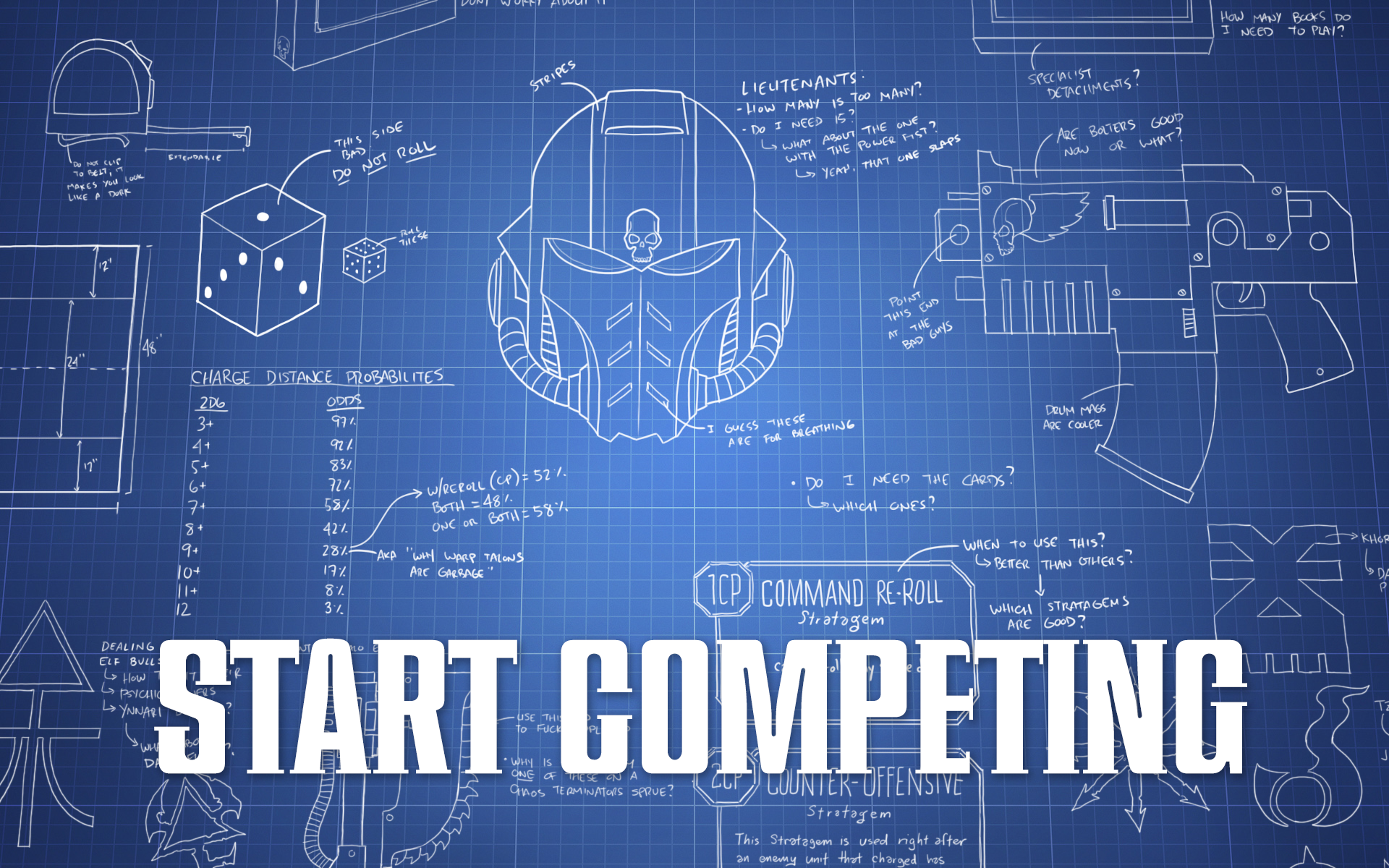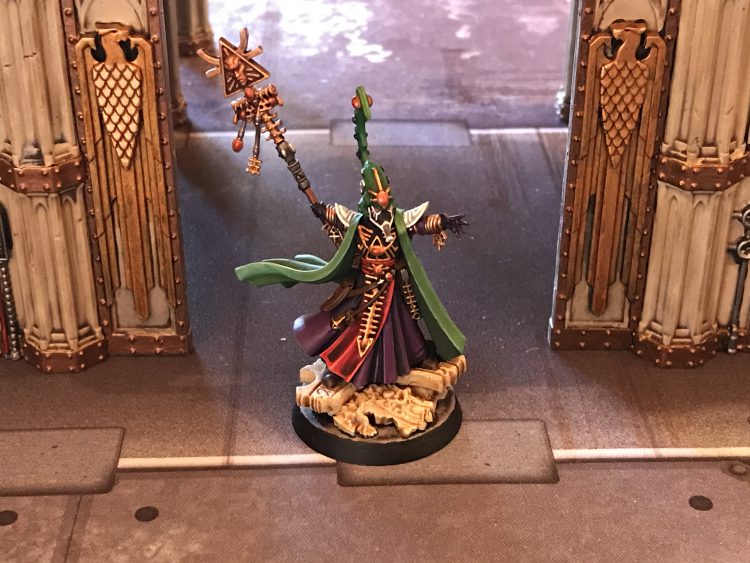Note: This Article was written for the 8th edition of Warhammer 40,000 and has yet to be updated. While many things may still work, the rules have changed fundamentally in 9th. As such, we recommend that you proceed with caution.
Here on Start Competing we produce plenty of guides to specific factions (go take a look at our guide to the Adepta Sororitas from last week for the most recent) but sometimes we like to take a step back and talk more generally about an aspect of strategy.
This week, we’re picking up a concept that’s central to 40k strategy, screening, and putting out a two part series it, specifically some of the tricks and traps to be aware of when moving or placing models around the board, starting today with a discussion about screening. We’ve been kicking around since reader George F contacted us in November, and while it may not sound super flashy, smart unit positioning can make a massive difference to the outcome of a game. As you go to more events and get a chance to play against top players you’ll realise that part of the reason they manage to so consistently put up big wins is that they’re always on the lookout for places they can squeeze a tiny bit more value out of a unit or stack the odds in their favour, and the movement phase is where a lot of this happens. Conversely, a big mistake in moving a unit or not spotting a trap your opponent is laying for you can flip a game winning position to a losing one, and while everyone makes these errors (almost everything I’m going to talk about is something I’ve messed up on a tournament table at least once), cutting down on them is vital if you want to put up big finishes of your own.
Obviously this is one of those subjects with a near infinite amount of depth to it, and I’m sure plenty of people will get to the end of this and think we’ve missed out on a big one – and if that sounds like you then do let us know on contact@goonhammer.com or in the comments, because we’d be only too happy to include them in a mailbag article or a future update.
There will also be a little bit of overlap in some of this with the last general tactics article I put out, which covered deployment. While the article needs some re-writes for the new ITC season, deployment is obviously a kind of positioning, and if you haven’t read that one it’s worth a look – some of the principles discussed there apply here too, and some of the tricks we’ll talk about with ruins and casualties can be applied to deployment too. With that final bit of preamble out of the way let’s discuss our first big topic – screening.
What is Screening?
Screening is a term you’ve almost certainly heard, but it’s a good one to start with, because getting the basics of it down is absolutely critical to not just getting swept off the board in some matchups. In simple terms, screening is using the positioning of some of your units to control your opponent’s ability to attack others. It’s most commonly talked about in reference to deep strike screening, but other common places it comes up are screening against charges and screening characters. You’ll also often see people referring to “screening units” when discussing army lists. This usually, bluntly, refers either to units that are cheap, can fill a decent amount of space and are expendable – because that makes them ideal for the purposes here. Alternatively, some units have special abilities that make them particularly good at one or more of the types, making them attractive to army lists that have a particular need to screen against a certain type of threat, even if they’re a bit pricier.
While similar units are often useful for multiple types, there’s a fair bit of difference in how to achieve each type, so in the rest of the article we’re going to talk about the various kinds of screening separately. There is one general thing you want to think about for all of them though – effective screening with multi-model units often requires you thinking more carefully about how far apart you’re placing models than new players often do. For our purposes today, it’s very often going to be the case that you want your models in one of three configurations:
- As far apart (i.e. 2″ between each) as possible, to cover more space.
- As close together as possible, to minimise attack surface.
- Slightly closer together than the size of your opponent’s models’ bases.
It’s easy to fall into a habit of just placing your models about an inch apart and leaving them at that, and that can be fine when you’re not using your models for any particular purpose, but once they’re part of a screen this matters – so think about it (and read our Ruleshammer article about this)!
Screening Against Deep Strike

Lots of units in 40K have the ability to start the game in reserve and then on turns 2 and 3 appear anywhere on the board that’s more than a certain distance (usually 9″) away from the opponent. The abilities that grant this have a huge variety of names, but are generally referred to as deep strike abilities. Corrode: I really hope they give this a keyword or USR in 9th ed, because it’s really annoying not to have a general term for what is basically the same thing. In addition to these, some armies have abilities that let them remove a unit from the board and set them up again, either immediately or on a later turn. The ones of these that work immediately are particularly important, because unlike deep strike deployment they can be used on turn 1, but the ones that “stagger” to the next turn also let a player carry out a deep-strike style setup later than turn 3, meaning that there are more turns where you have to be mindful of it when your opponent has access to them. This latter set of abilities are sometimes referred to as redeploy abilities, but often just lumped in with deep strike as well. I’ve put a quick list of some of the most common of these and who they can affect in the drop-down below.
Common Redeploy Abilities - Click to Expand
Drop pods in Space Marines can also be used to deep strike on turn one, so need to be planned for like a redeploy.
Anyone who’s played against these armies in a competitive setting will probably recognise these – and that’s because they (and deep strike in general) are very powerful. At a basic level, setting up with these abilities can let a player either:
- Put units in places where they’d otherwise not be able to go, like behind the opposing army.
- Put units in a position to charge or shoot a key target without having to move into position naturally.
Both can be hugely valuable – getting to an otherwise protected position can let you attack vulnerable enemy units or go for objectives in a way that wouldn’t normally be possible, while bringing a heavy hitter right in front of the enemy gives them a chance to strike first, doing damage before your opponent can fight back against them. The latter is especially valuable for powerful melee units that have a way to boost their chance of a successful charge on the turn they arrive (as the probability of a 9″ charge is otherwise a bit dicey). Plenty of powerful armies lean heavily on deep strike as an option, with Blood Angels, Raven Guard, Grey Knights and Genestealer Cults being particularly notable.
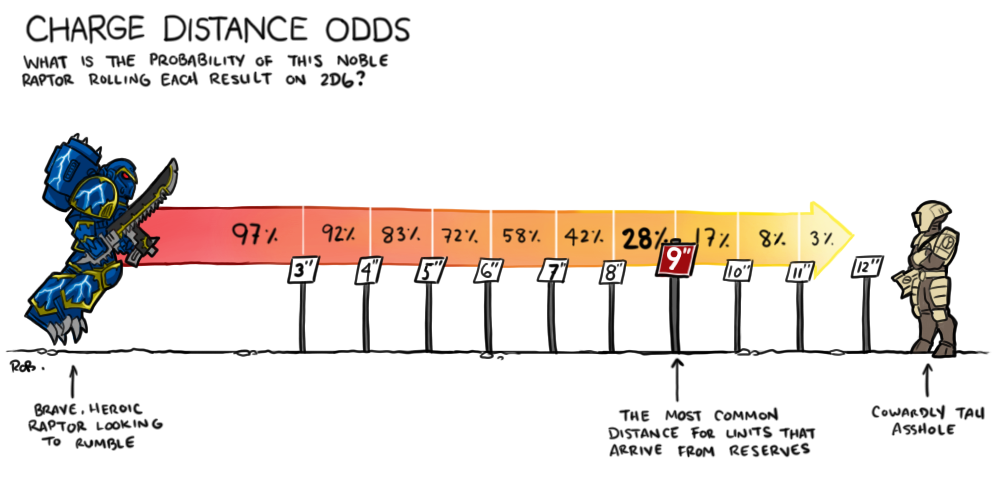
The two goals you have when up against one of these armies is to use screening to directly counterattack the ways your opponent gets value out of it. Specifically, you want to:
- Use overlapping 9″ zones around your units to block out sections of the board.
- Use screening units to ensure your good units can’t be attacked by enemies arriving from deep strike.
Zoning Out the Board
When planning to protect against deep strike, you should think about each of your models having a 9″ “bubble” around them that protects from deep striking. A 9″ radius circle is surprisingly big (it’s roughly 7% of the total area of a standard 6’x4′ table) and when you start visualising this you’ll quickly discover that you can very easily ward off large sections of the table with relatively few models. Because the bubble extends out from every unit, two of your models (say two characters) 18″ apart create a straight line between them where deep strikers can’t arrive.
Meanwhile, two units of 5 infantry on 25mm bases that are spaced out to the maximum coherency distance of 2″ (remembering that this is a thing we should be thinking about) can successfully screen off the entire width of the board. Allowing for the mystical properties of triangles, you can have this unit about 6.5″ in from one short edge of the board and have their bubble reach all the way to the corners, and then a minimum of 6.5″ further up the board (and a bit more for most of the width). Adding in the base size, you’re looking at around 1/5th of the whole table warded off by a single unit.

You can also achieve roughly the same backline cover using one unit of 5 infantry and two characters:
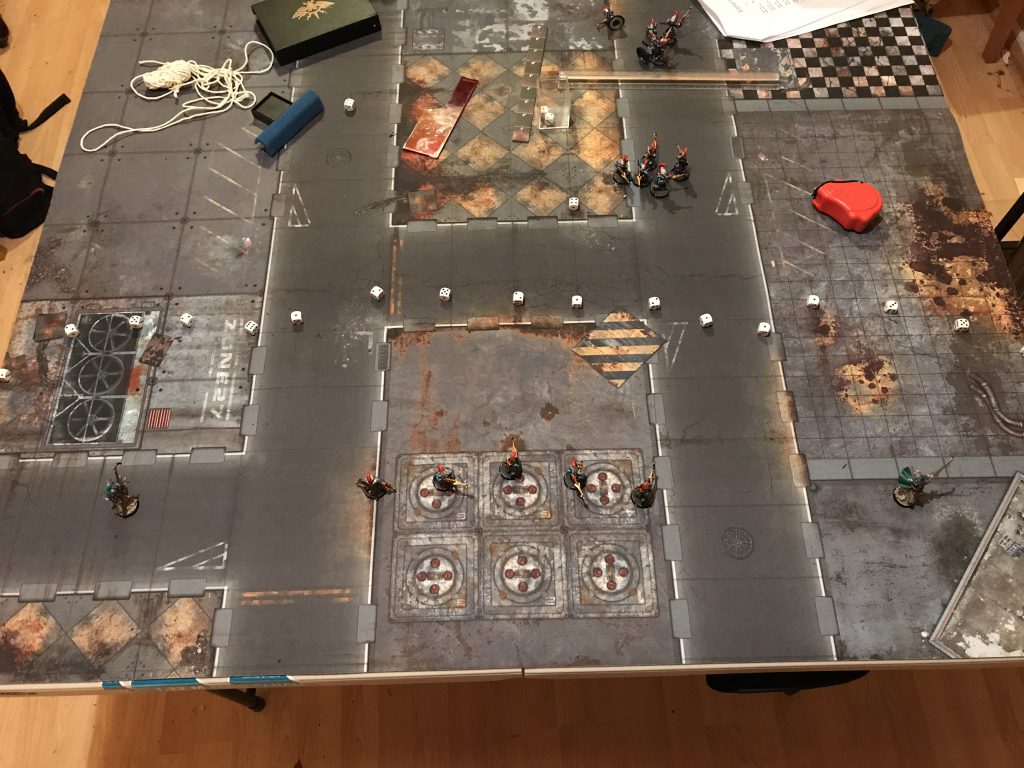
This lets you completely zone out (a term you’ll often hear used for setting up this kind of screening) your back-line very efficiently, and is also a useful technique for filling in gaps between your back and front lines as you move up the board. If you’re playing a very mobile army against a deep strike heavy army, you can also sometimes turn this around and go on the offensive with it – if you take the first turn and spread your units out widely, you can restrict your opponent’s possible space for bringing in units to a very small part of the table. You shouldn’t do this unless you’re confident you can pull it off, as trying and failing can leave you strung out and exposed, but if you know what you’re doing it can put some armies on the extreme back foot.
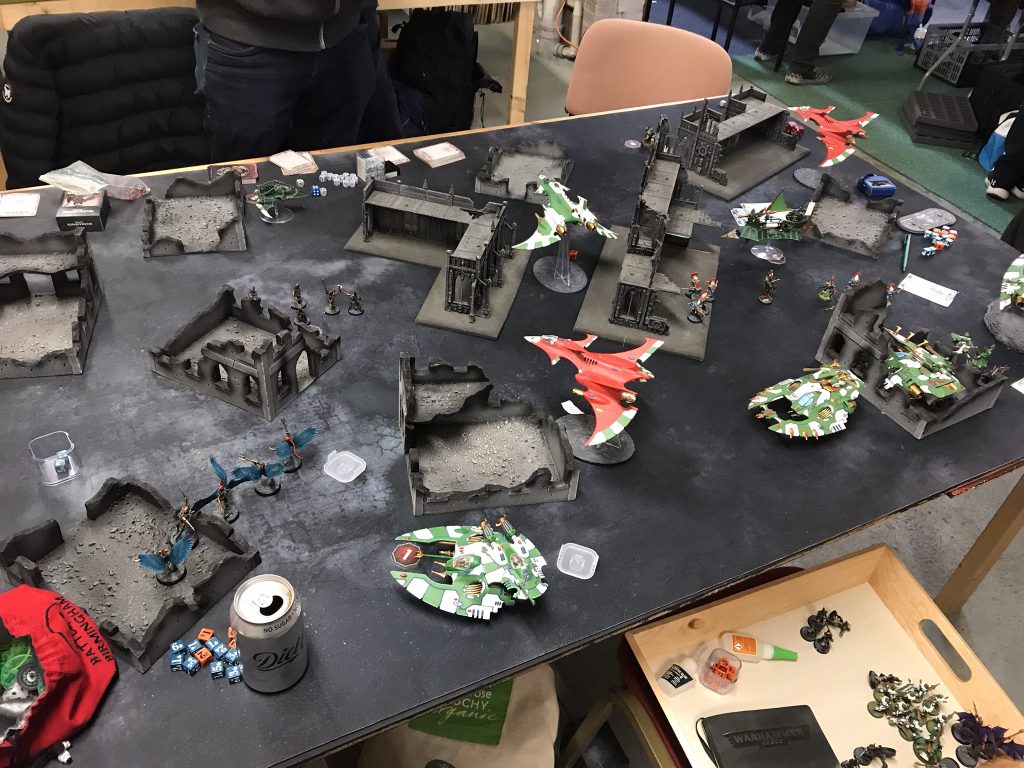
Keeping your parts of the board zoned out against deep strikers is extremely important and a skill you must develop early on if you want to play competitively, because if you needlessly let your opponent drop powerful units in your backlines you will, bluntly, just lose games that might otherwise have become wins. Always take a moment at the start of the movement phase to work out how you’re going to maintain your overlapping bubble of safety, and when you’re down to your last few units to go make sure you’re checking the distances between them and ensuring there are no chinks in the armour – very dangerous single models like smash Captains or an Imperial Assassin only need a small gap left to pop in and cause some mayhem.
Protecting Your Units
Once you’ve got this important fundamental down you can turn to the other way to fight back against deep strikers – shielding your key units. While deep striking helps enemy units get into an attacking position, it doesn’t give them unlimited reach – weapons will still have a range, and most units can only charge if they’re within 12″ of their target. If you have some units you really don’t want to get bodied by enemy deep strikers, then you can use other, less valuable friendly models to zone out where they can drop to prevent them getting the juicy stuff. Sure you’ll probably lose the unit you screen with – but casualties are inevitable on the battlefields of the 41st millenium, so sometimes the best you can do is control who the casualties are.
Against shooting threats the principles here are very similar to screening your back line – push out some cheap, expendable infantry out far enough ahead of your key units that your opponent can’t land within range of them. The same considerations of overlapping bubbles apply, and you generally want to spread the models you’re using out to occupy maximum space. If you have units that can deploy outside your own deployment zone (such as Space Marine Scouts), you can even set this up when you’re going second if your opponent has a threat like a Drop Pod of grav Devastators that will ruin your premium vehicles.
You can use a similar process to try and protect against charges, and it will sometimes be correct to, but here doing so opens up a risk. People have gotten good enough at screening key units from deep strike charges that the core strategy for a lot of deep strike melee armies has changed such that the screen itself is now the initial target.

Using a “wrap and trap” (as discussed in our fight phase tactics guide) they can set up a situation where they end the turn they arrived having trapped an enemy screening unit in combat. This unit is then messily dispatched in its owner’s turn, without the rest of their army being able to shoot the deep strikers in the meantime, and from there the real rampage begins. Chaining wrap and traps is a key tactic for melee armies – but if you try to avoid it by not screening, then you’re straight back to a risk of getting your best units charged. So what do we do?
Generally, one of two options will help you out here:
- Screen with units that are difficult to charge, can’t be wrapped, or can escape one.
- Set up so that you can punish a wrapping unit.
Which you choose will generally depend on what you’re trying to protect. If most of your army is shooting based (sorry Tau) it’s pretty unlikely that you’ll be able to prise an enemy out of a successful wrap. However, if you use FLYing models (e.g. Tau drones) as the outer layer of your screen then you’re safe from this – even if a model get surrounded, the screening unit can leave combat and open the chargers up for some shooting-based revenge. Even better here is to use a flying unit that can’t be charged at all (e.g. AIRCRAFT against ground units) or are hard to charge (e.g. Impulsors with their -2″ charge ability, Eliminators with instigator carbines). If you have AIRCRAFT around they can also provide a safe place for ground units, which can be helpful if you need to both screen and grab an objective:
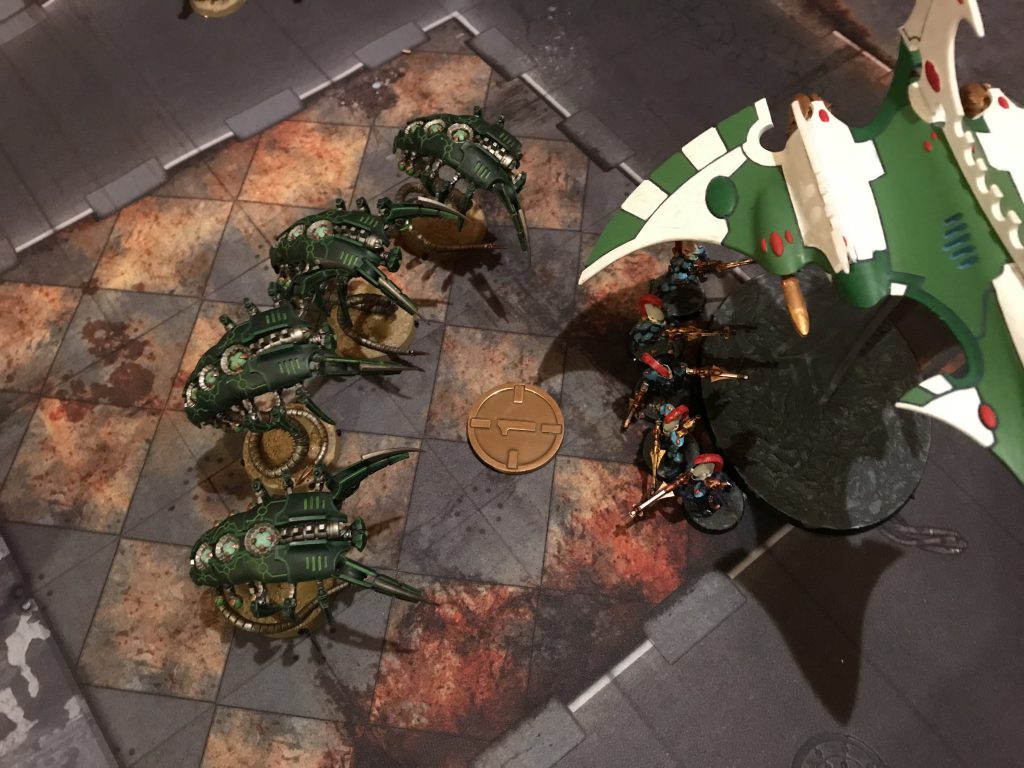
The final option is to put out something with overwatch sufficiently brutal that charging it is too high a risk (e.g. Long Ranged Marksmen Assault Centurions), preventing a safe charge.
Sometimes this will mean using a more valuable unit than you otherwise would to screen with – but in the melee vs. shooting matchup the melee army is often sufficiently reliant on chaining wraps that the trade is worth it. Also, remember that units using “standard” deep strike abilities have to come in on turn 3 at the latest, so if you can get that far without presenting them with a good opening then you’ve likely denied a decent chunk of their value, and again trading some amount of materiel for that is worthwhile. Also, while you potentially will lose the screening unit if your opponent decides to “settle” for killing it, if they decide that it isn’t juicy enough you might well keep it – and still be able to screen with it the next turn.
That’s the purely defensive option – your other plan is to prepare for a counterattack. This usually works best if you have a powerful melee threat of your own, but can also be viable if you have huge psychic output, as you can Smite into combat with impunity. Here, you’re fine to use something that can be wrapped as a screen, and rather than keeping your valuable stuff a hefty distance back, you instead want to have it only a small distance back from the screen – importantly, far enough back that you’re at least 12″ back from the closest point the enemy can deploy (plus any additional distance needed to account for abilities like Perfect Ambush). As long as your opponent can’t declare a charge on your powerful unit they aren’t going to be able to fight it – and if they then come in and wrap your screen, you can counter charge in your turn and do massive damage to their good stuff.
In melee vs. melee army matches, a big part of the interplay of the early game comes down to trying to use low-value units to screen your high value melee units while controlling as much of the board as possible – the goal becomes to force your opponent to commit to a charge into a weaker unit to avoid falling behind on objective-based scoring, which then allows you to get the first swing with your good stuff and clean up.
The only time you have to be a bit careful about this is against opponents with a mix of shooting and melee threats – because setting up a powerful melee unit of your own for a countercharge can leave them exposed to shooting options. This is one of the sources of the strength of the Raven Guard Centurion armies that mix a unit of grav Cents in with the assault ones – it can be extremely difficult to devise a screening strategy that accounts for such powerful units of both classes. That’s the kind of matchup where experience with your own army is important – it lets you assess what you can afford to lose in any given moment, and thus which threat to tune your screening towards.
A final thing to be wary of when considering deep strikes is that some units can break the normal rules. Genestealer Cults, Tau, Grey Knights, Raven Guard and Dark Angels all have ways of bringing units in closer than that magic 9″. Generally they do still have some limits on them, but you need to adapt the distances you’re screening at to deal with these. As ever when you’re trying to improve at competitive play, don’t be afraid to ask your opponent if they have anything that lets them do this – because if they do you need to know about it.
Charge Screening

Not all chargers come from deep strike, and some of them are very fast indeed. Plenty of units that want to get in a fight with you are perfectly capable of speeding their way across the board, perhaps via Advance and Charge abilities or psychic powers such as Warptime that let them move twice. While this can require more investment from your opponent and means their units might be more vulnerable, it also frees them from some of the constraints of deep striking – it’s quite likely that they’ll have the speed to make it considerably closer than 9″ from your units if you let them, so a screen that pushes your bubble out slightly more than 12″ from your key stuff probably isn’t good enough any more. Plenty of good combat units can also move over or through enemy models, and come the charge phase can also simply go around your front units to get to juicier targets if needed – effective use of charge and pile in moves provides an incredible amount of mobility.
When you’re up against a combat army, therefore, as well as considering how to protect against deep strikers you need to be thinking about how you can block the charges your opponent wants to make with the units they’ve got on the board. This time, rather than a 9″ bubble around your models, your tools for achieving this are the models themselves.
Unless an enemy unit has a special ability such as FLY, they can’t move their models:
- Through the bases of your models
- Through the hulls of units that measure to the hull
- Within 1″ of one of your units that unit they aren’t charging
Even if they do have FLY, they can’t place their models in a position where there isn’t enough space for their base, or they can’t ensure coherency for their whole unit.
If you don’t want to get charged, that gives you a number of ways to ensure it. First up, against non-flying units you can use a screen of models that are close enough together to prevent an enemy base fitting through to stop a charge.

This is a great way to let cheap units protect good ones from charges, especially as quite a large number of relevant melee threats are on 40mm or larger bases. When doing this, make sure to consider whether the opponent has access to a fight twice ability – if so, make sure to put your screen far enough in front of your quality units that the opponent can’t:
- Declare a charge on the good stuff too
- Fight and kill the screen
- Consolidate within 1″ of the good stuff
- Fight again
That’s a great way to nearly get things right and throw it away at the last moment! You will observe above that OVERLORD WINGS has wisely deployed his minions a healthy distance away – in this case more than 4″ from the back of his unit’s bases, so that the Wraithblades cannot come within an inch even after using pile-in and consolidate moves. Be like OVERLORD WINGS.
Just like with zoning off the board, this is something you can sometimes use more proactively, especially against units with extremely large bases that can’t move through terrain.

In the above picture, by moving a screen of extremely expendable minions up to physically block the space between the ruins, OVERLORD WINGS has ensured that he can’t get shot or charged by the Knight this turn (assuming nothing else has a bead on the Scarabs). The Knight has moved as close to the swarms as it can in the movement phase, but still isn’t within 12″ of our nefarious galactic overlord, so even if it shoots out the Scarabs it can’t launch a charge. This gives OVERLORD WINGS time to bring up some heavy firepower, flee like a coward tactically withdraw or otherwise do stuff without the Wraithknight being able to do much.
Units that can move through your stuff present a bit more of a challenge, and require you to instead deny them the space they need to land. Below, some Dire Avengers are demonstrating how to do just that.

The Wraiths are presumably even hangrier than before, and what they really want to do is either wrap some Dire Avengers or maim the Night Spinner, but they can do neither. The Dire Avengers are far enough out from the tank that Wraiths on the far side of them aren’t within 1″ of it – but close enough to it that there isn’t space to fit Wraiths between them and the tank. Despite the Wraiths teleporting shenanigans they still can’t achieve what they want.
This can be harder to pull off against units with smaller bases, but is still sometimes possible if what you really need to protect is relatively small. Against enemies like Solitaires and Smash Captains, I relatively frequently use a triangle of Eldar vehicles to protect my characters, again taking advantage of the fact that your opponent just can’t fit them where they want to go:

With a bit of careful planning, and a proper assessment of what you really can’t afford to lose, putting some level of screening in place is almost always possible unless you’re in dire straits. As with protecting yourself against deep strike chargers, just remember to consider whether your screen can become a target in its own right, and don’t let yourself get wrapped up.
Character Screening
The final of the three most common types of screening you see is screening characters. In 8th edition, a CHARACTER with a wounds characteristic <10W cannot be targeted by a shooting attack as long as any other type of friendly model (i.e. non-CHARACTER or CHARACTER with 10W+) is nearer to the shooting unit. Characters tend to be very deadly for their cost but also somewhat vulnerable, so when using them in armies it’s vital to use this rule to keep them safe, and positioning other units to achieve this is referred to as character screening.
Compared to the other topics discussed here, this swings way more wildly on how difficult it is to achieve. On the one hand, pretty much any of your units can do it, and you don’t need to be especially careful with how you’re placing them unless you’re also screening for something else. On the other, it’s a moving target compared to charge screening. If your opponent starts their movement phase with no way they can get within 12″ of your key units, they aren’t charging them that turn outside some very unusual abilities, even if they blast the screen away in the shooting phase. With character screening, if you haven’t put enough stuff in the way, a good shooting phase might let your opponent blast all the way through your screen and then take out the characters themselves.
In order to prevent this, there are four things to consider:
- Have you screened from every angle they can attack? Watch out for AIRCRAFT swooping in to snipe people.
- Roughly how much damage can they do to a screen on an average turn? Have you put enough units in the way to account for that?
- Can you make any screening units unusually durable?
- Can you make any screening units outright untargetable?
The first two points are something where building up familiarity with what factions are capable of will help. For the first point, AIRCRAFT are usually pretty conspicuous but do be aware of units using double move abilities to get to a good position. For the second, playing against a faction a few times should equip you with a decent sense for what an average shooting phase looks like for them, letting you put out a sufficiently tough screen to weather it.
The last two points are where you can make a big difference moment to moment. Units that make unusually durable screens tend to either:
- Be buffable with a stratagem to increase their defences.
- Be troop transports with more units inside.
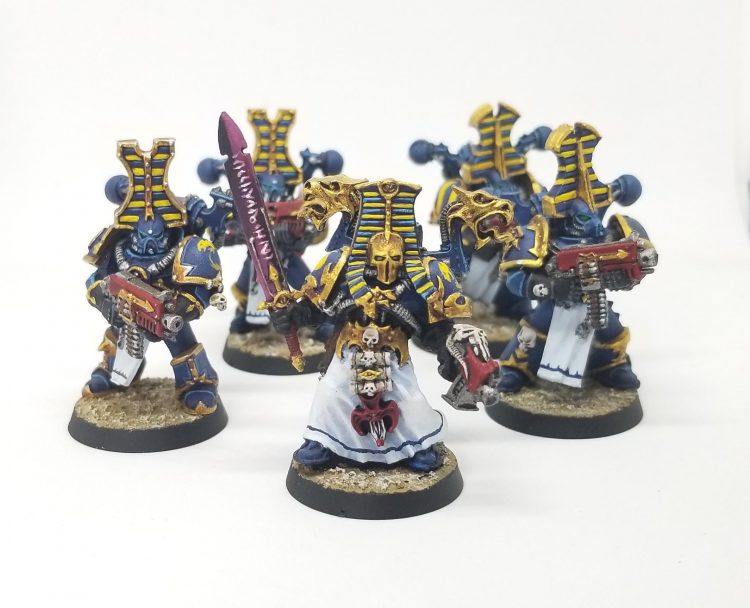
Sometimes when you use a phase-long defensive stratagem like Indomitable Foes, your opponent can respond to it by just changing their target, reducing the impact of your CP expenditure. If the unit you buff is part of a screen your opponent was hoping to crack, however, the value is much higher – either they switch targets and abandon the plan of shooting your characters, or they keep shooting the buffed unit and get less overall output from their army for the turn. Either way this helps you – and it helps you even more if they pick the second option but you’ve deployed enough other stuff in the screen such that they still don’t get through. If you’re on the other side of this – do be wary of falling into a “sunk cost” trap once you’ve planned to shoot out a screen – against an experienced opponent you might be being baited into a trap.

Troop transports are the other generically good choice here because when they die they can put additional units into the screen as their contents disembark. This is an especially potent trick against armies such as Imperial/Chaos Knights who have a small number of high-powered shooting units. Because a unit has to declare all of its shooting at once, a Knight that starts blasting a troop transport doesn’t get a chance to shoot what’s inside once they come out. Because of the same rule if there are any units screening your CHARACTER at the point a unit declares its targets then they can’t shoot the CHARACTER. That combines to mean that a humble Venom containing five Kabalite Warriors can near-guaranteed screen out a character from two enemy Knights in the shooting phase (unless you’re absurdly unlucky and roll a quintuple 1 when they get out). Knight meta is long in the past, but knowing how to eke out the most screening value from your units in the lategame against them was tremendously important at the time, and will be again if they ever come back (Corrode: I bet this looks prescient in a few weeks when Engine War is released.)
Your other option, even more reliable than using durable units or transports, is to just put something your opponent can’t shoot at all between your characters and them. The easiest way to do this, especially if you’re playing at an event with enterable enclosed ruins (“magic boxes”), is to put a unit out of sight between your character and the enemy.
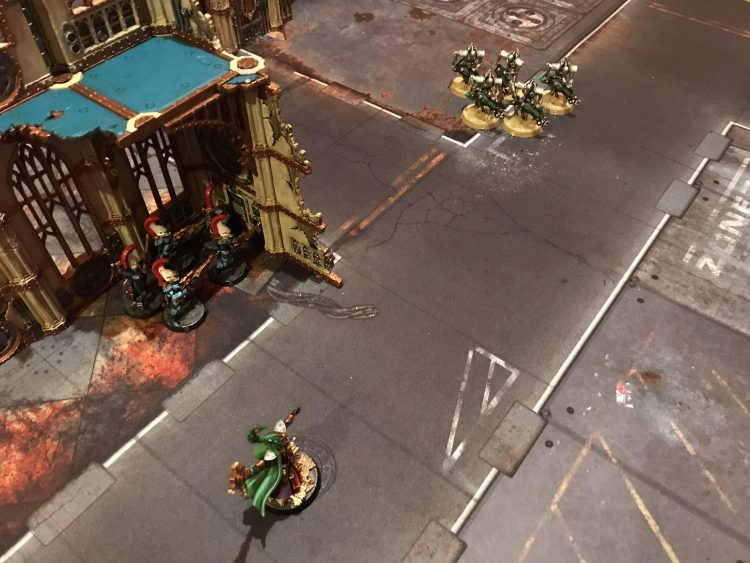
This is available to pretty much anyone and very helpful in a pinch. I wouldn’t say I’m exactly proud of a game I won because a lone surviving Guardian (my only non-CHARACTER model alive) huddled in a magic box for three turns while a Castellan couldn’t shoot anything, but I did win it. There are also some psychic powers and stratagems which make a unit untargetable unless they are the closest, so much like the above discussion on using transports to provide a layered screen, you can use these to slow down your opponent’s ability to chew through your screening units.
When doing this, do watch out for your opponent finding innovative ways to take out your hidden screen. Some weapons (and the odd psychic power like Executioner) don’t need line of sight, and can just blast your unit out of the way. Alternatively, if you’ve left them too close to a wall they’re huddling behind, your opponent might be able to use them as a charge target – the Dire Avengers in the picture above can be within 1″ of a charger from the other side of the wall, and might benefit from standing a half inch further back to prevent this kind of charge against them – especially if they’re in a magic box which means they’re enclosed on all sides and would prevent something like a Knight or another non-INFANTRY unit from charging them at all.
Your final and probably most reliable way of providing a character screen is by wrapping an enemy unit with one of yours. This is a favoured tactic of Genestealer Cults, leaning on wraps to protect both their key melee units and screen their vulnerable characters. However, while charging and wrapping from deep strike is usually only something melee focused armies aim for, wrapping like this can sometimes be worth it even using non-dedicated melee units, if you have a character that needs protecting.
This works, obviously, because your opponent can’t shoot a unit that’s in combat – so if such a unit is between them and your leaders, there’s nothing they can do about it unless they have enough smites to clear the whole wrapping squad (which is unlikely outside of Grey Knights and Thousand Sons). If you’re worried about attacks from multiple angles, and can’t screen them all but do have access to a squishy enemy unit you can wrap, you can go even further and charge your character into the combat once you’ve sent your wrapping unit in. Choosing to use their basic melee weapon should hopefully avoid killing too many of the enemy, and if you can stick your character into a combat the enemy isn’t escaping from you definitely aren’t getting shot – just make sure you aren’t opening yourself up to revenge charges instead.
You can, occasionally, even do this with units that aren’t characters, especially if they’re shooting units that FLY and can thus leave combat on your next turn with impunity. A recent Tau opponent used a squad of drones to wrap up some Dire Avengers I’d overextended then charged a a Riptide into them as well, stopping me effectively attacking it on my turn.
Just like with charge screening, it’s almost always possible to successfully screen your characters until a game has gone badly south – and even then it’s usually possible to make your opponent’s life difficult. Because they’re hard to target, your characters will often be some of your last models left, and maximising how long they stay alive in a close game can be what allows you to snatch victory from the jaws of defeat.
Wrap Up
That happy note is a good place to close out this piece, and hopefully if you’ve heard of screening but weren’t quite sure how to do it well you now feel a bit better equipped. In a few week’s time I’ll be back with another piece on positioning, looking at how you can squeeze value out of the positioning of your models, your opponent’s and terrain. In the meantime, if you have any comments, questions or suggestions hit us up in the comments, on Facebook, or at contact@goonhammer.com.
